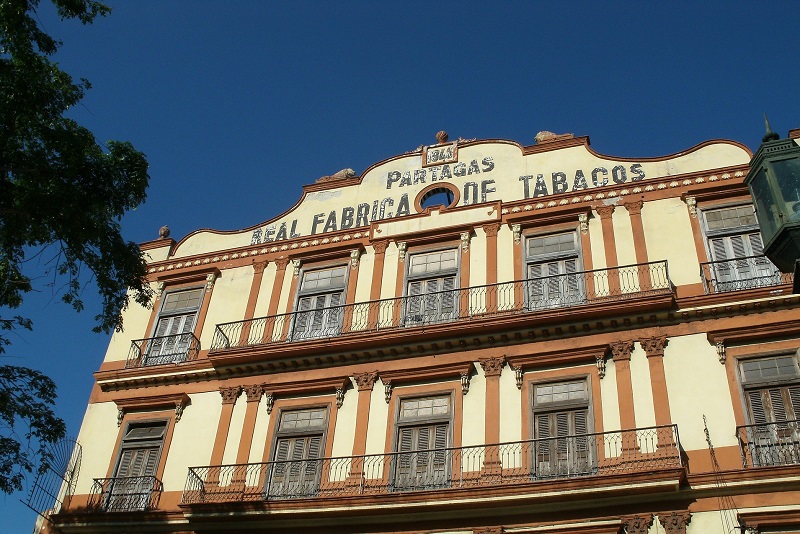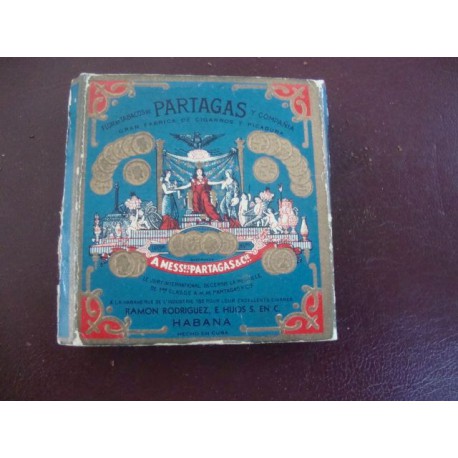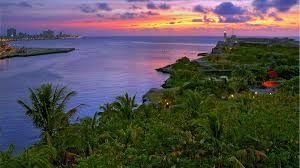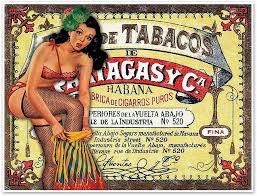CIGARROS Y TABACOS “PARTAGÁS”, LA HABANA, CUBA Y SUS DUEÑOS MISTERIOSAS MUERTES. PHOTOS
Son muchos los emigrantes españoles que viajaron a Cuba en el siglo XIX y que se dedicaron al tabaco, no sólo en la manufactura sino también en el campo, pero pocos personajes tan avanzados y polémicos como Jaime de Partagás.
Al otro lado de la calle del enorme edificio del Capitolio de La Habana, se encuentra una de las fábricas de cigarros más antiguas de Cuba. La Real Fábrica de Tabacos Partagás está ubicada en un edificio industrial bien conservado que data de 1845. El edificio destaca entre sus vecinos por su exterior ornamentado y colorido en color granate y crema. La Real Fábrica de Tabacos Partagás es un museo de fábrica de cigarros en La Habana, Cuba. En esta fábrica se producen los mundialmente famosos habanos.
Jaime Partagás Ravell, fundador de la fábrica de tabacos cubanos que aún hoy lleva su nombre, nació el 7 de diciembre de 1816 en Arenys de Mar, ciudad cercana a Barcelona, España. Con sólo 14 años navegó hacia Cuba, y cuando tenía 18 se inició en el negocio del tabaco con ayuda de sus amigos.
La Flor de Tabacos de Partagás apareció en el registro de los nombres de marcas en 1827. Don Jaime Partagás, era el propietario de una pequeña fábrica de tabaco en La Habana en 1827.
Desde el principio, tenía la ambición de emprender una producción a mayor escala, pero no disponía del capital suficiente para entrar en el grupo de los grandes. Mientras esperaba su momento oportuno, se dedicó juiciosamente a comprar distintas plantaciones de la región de Vuelta Abajo. Tardó veinte años en conseguir el interés de los inversores en su proyecto. Cuando tuvo el apoyo necesario, creó la empresa La Flor de Tabacos de Partagás y Cía.
Hacia 1838 comenzó a torcer puros y abrió su propia fábrica en la calle Industria, La Habana. En 1844 crea la marca “La Flor de Tabacos de Partagás y Compañía”. Por esta época compró en la provincia de Pinar del Río la finca “Hato de la Cruz”, para el cultivo de tabaco, con 45 agricultores. Además, creó dos tiendas donde los agricultores pueden adquirir a crédito todo lo necesario para su hogar y para el trabajo del campo.
La marca alcanzada y aún tiene singular prestigio dentro de los habanos más fuertes y con un aroma de más cuerpo. La calidad del tabaco es excepcional dado que don Jaime Partagás fue de los primeros en concentrarse meticulosamente en las técnicas para mejorar la producción, especialmente en el área de fermentación. La fábrica en la que se elaboran los cigarros queda en la Calle de la Industria, en un suntuoso edificio de estilo colonial. Todavía sigue allí, actualmente, y, aunque ha pasado por una renovación en 1987, sigue siendo la fábrica más antigua de cigarros. Es una de las mayores atracciones turísticas de La Habana, una visita imprescindible.
“PARTAGAS” Y MISTERIOSAS MUERTES DE SUS DUEÑOS
En 1868, y por la posible rivalidad en los negocios, fue asesinado Jaime Partagás.
Lo misterioso de Jaime Partagás fue su muerte, ocurrida el 18 de julio de 1868 en Pinar del Río. Aunque finalmente alguien fue declarado culpable del asesinato, no está claro quién fue realmente, qué pasó o, por supuesto, cuál fue el motivo. Para empezar, existen dos versiones de la muerte. En uno, Jaime Partagás fue encontrado muerto, baleado, en medio de una de sus plantaciones en Vuelta Abajo. La otra versión dice que solo resultó herido en la cabeza, pero que, a consecuencia de esa lesión, sufrió una infección meníngea que lo mató al mes.
También existen varias versiones sobre quién fue el asesino y el móvil del crimen: la más conocida, y la que posiblemente tenga menos peso, es la de un crimen pasional. Al parecer, don Jaime viajaba mucho desde La Habana a Vuelta Abajo para supervisar sus plantaciones, porque era un hombre tremendamente exigente y riguroso. El tabaquero aprovechaba sus viajes para dar rienda suelta a su otra gran pasión: las mujeres. El tirador, según esta versión, podría haber sido algún marido engañado que lo esperaba.
El otro móvil posible sería la envidia de su competencia directa. Uno de los sospechosos era un fabricante de tabacos llamado Pedro Mató, quién comido por la envidia de no haber alcanzado el éxito empresarial de Jaime Partagás, contrató a un negro, llamado Antonio Díaz, por una moneda de oro para que le descerrajó el disparo. De hecho, fue el negro el que cargó finalmente con la culpa. Otro sospechoso fue Carbajal, yerno de Cabañas, dueños de la marca Hija de Cabañas y Carbajal, que estuvieron en litigio con Partagás durante seis años por el nombre de una marca que era de Carbajal y que Partagás usaba en Inglaterra.
SIGUEN LOS SUCESOS EN LAS PROPIEDADES DE “PARTAGAS”
Las propiedades de Partagas pasaron a su viuda e hijos. Luego, vendieron la fábrica con sus marcas y la finca al asturiano Juan A. Bances. Cuando cerró el negocio, el señor Bances vendió la fábrica de tabacos al señor Ramón Cifuentes.
El Sr. Cifuentes, en sociedad con el Sr. José Fernández, crea la firma “Cifuentes, Fernández y Compañía”. En 1914 el señor Cifuentes compró acciones que tenía el señor Fernández en la empresa y se las vendió a don Francisco Pego Pita. Ahora, el nombre de la sociedad era “Cifuentes, Pego y Compañía”. Esta sociedad compró en 1927 la empresa “Allones Ltd.”, junto con sus marcas “La Eminencia” y “Ramón Allones”. La marca “Ramón Allones” pasó a ser la segunda más importante de la Compañía, después de “Partagás”. En el año 1927 los hermanos Benjamín y Alonso Menéndez, propietarios de “H. Upmann”, vende a “Cifuentes Pego y Compañía” sus marcas “Particulares” y “Byron”.
Ramón Cifuentes falleció en España en abril de 1938. Sin embargo, la empresa permanece con el nombre de “Cifuentes, Pego y Compañía”. En 1940 las marcas “La Gloria Cubana” y “Bolívar”, pertenecen a la empresa “J.F. Rocha y Compañía” desde 1905 y 1921 respectivamente, también fueron adquiridas e incorporadas a las producciones de la fábrica de Partagás.
En noviembre de 1940 falleció en La Habana Francisco Pego Pita, hasta el momento de forma misteriosa. Pocos meses después sus herederos deciden abandonar la empresa y el 12 de agosto de 1941 quedan propietarios Ramón, Rafael, Manuel y Leandro Cifuentes, hijos de Ramón Cifuentes. Entonces, la sociedad pasó a ser “Cifuentes, Álvarez y compañía”.
Finalmente, el 14 de abril de 1962, la marca “Partagás” y las demás de “Cifuentes, Álvarez y compañía” fueron “nacionalizadas” por el Régimen cubano pasando a ser propiedad de la “Empresa Cubana del Tabaco”.
CIGARETTES AND CIGARS “PARTAGAS”, LA HAVANA, CUBA AND THEIR OWNERS MYSTERIOUS DEATHS. PHOTOS
There are many Spanish emigrants who traveled to Cuba in the 19th century and who dedicated themselves to tobacco, not only in manufacturing but also in the fields, but few characters as advanced and controversial as Jaime de Partagás.
Across the street from the massive Capitol building in Havana, is one of Cuba’s oldest cigar factories. The Real Fabrica de Tabacos Partagas is housed in a well-preserved industrial building dating from 1845. The building stands out amongst its neighbors because of the ornate colorful maroon and cream exterior. The Real Fabrica de Tabacos Partagás is a cigar factory museum in Havana, Cuba. The world-famous Habanos cigars are produced in this factory.
Jaime Partagás Ravell, the founder of the Cuban cigar factory that even today has his name, was born December 7, 1816, in Arenys de Mar, a city near Barcelona, Spain. With only 14 years old, he sailed to Cuba, and when he was 18, he started in the business of tobacco with the help of his friends.
La Flor de Tabacos de Partagás appeared in the registry of brand names in 1827. Don Jaime Partagás was the owner of a small tobacco factory in Havana in 1827.
From the beginning, he had the ambition to undertake production on a larger scale, but he did not have enough capital to enter the group of large companies. While he waited for his opportune moment, he judiciously dedicated himself to purchasing different plantations in the Vuelta Abajo region. It took him twenty years to get investors interested in his project. When he had the necessary support, he created the company La Flor de Tabacos de Partagás y Cía.
Towards 1838 he began to twist cigars and open his own factory on Industria Street, Havana. In 1844, he created the brand “La Flor de Tabacos de Partagás y Compañía”. By this time he bought in the county of Pinar del Río the farm “Hato de la Cruz”, for the cultivation of tobacco, with 45 farmers. In addition, I have created two stores where the farmers can acquire by credit all they need for their homes and for the work in the fields.
The brand achieved and still has a unique prestige within the strongest cigars with a fuller-bodied aroma. The quality of the tobacco is exceptional given that Don Jaime Partagás was one of the first to meticulously focus on techniques to improve production, especially in the area of fermentation. The factory where the cigars are made is on Calle de la Industria, in a sumptuous colonial-style building. It is still there today, and although it underwent renovation in 1987, it is still the oldest cigar factory. It is one of the biggest tourist attractions in Havana, an essential visit.
“PARTAGAS” AND MYSTERIOUS DEATHS
In 1868, possible due to rivalry in business, Jaime Partagás was killed.
The mysterious thing about Jaime Partagás was his death, which occurred on July 18, 1868 in Pinar del Río. Although someone was eventually convicted of the murder, it is not clear who it really was, what happened, or, of course, what the motive was. To begin with, there are two versions of death. In one, Jaime Partagás was found dead, shot dead, in the middle of one of his plantations in Vuelta Abajo. The other version says that he was only injured in the head, but that, as a result of that injury, he suffered a meningeal infection that killed him within a month.
There are also several versions about who the murderer was and the motive for the crime: the best known, and the one that possibly has the least weight, is that of a crime of passion. Apparently, Don Jaime traveled a lot from Havana to Vuelta Abajo to supervise his plantations, because he was a tremendously demanding and rigorous man. The cigar maker took advantage of his trips to unleash his other great passion: women. The shooter, according to this version, could have been some deceived husband who was waiting for him.
The other possible motive would be the envy of its direct competition. One of the suspects was a tobacco manufacturer named Pedro Mató, who, overcome by envy at not having achieved the business success of Jaime Partagás, hired a black man, named Antonio Díaz, for a gold coin to shoot him. In fact, it was the black man who ultimately took the blame. Another suspect was Carbajal, son-in-law of Cabañas, owners of the Hija de Cabañas y Carbajal brand, who were in litigation with Partagás for six years over the name of a brand that belonged to Carbajal and that Partagás used in England.
Partaga’s properties passed to his widow and sons of him. Then, they sold the factory with its brands and the farm to the Asturian Juan A. Bances. When he went on business, Mr. Bances sold the cigar factory to Mr. Ramón Cifuentes.
Mr. Cifuentes, in partnership with Mr. Jose Fernandez, create the firm “Cifuentes, Fernandez y Compañia”. In 1914 Mr. Cifuentes bought shares has Mr. Fernandez in the company and sold it to Mr. Francisco Pego Pita. Now, the name of the society was “Cifuentes, Pego y Compania”. This society bought in 1927 the enterprise “Allones Ltd.”, together with its brands “La Eminencia” and “Ramon Allones”. The brand “Ramón Allones” became the second most important in the Company, after “Partagas”. In the year 1927 the brothers Benjamin and Alonso Menendez, owners of “H. Upmann” cigar factory, sell to “Cifuentes Pego y Compania” its brands “Particulares” and “Byron”.
Ramón Cifuentes died in Spain in April 1938. However, the enterprise remains with the name “Cifuentes, Pego y Compania”. In 1940 the brands “La Gloria Cubana” and “Bolívar”, belong to the enterprise “J.F. Rocha y Compania” since 1905 and 1921 respectively, were also purchased and incorporated to the productions of Partagás factory.
In November 1940 Francisco Pego Pita was dead in Havana, so far in a mysterious death. Few months later his heirs decided to leave the enterprise and in August 12, 1941 were proprietors Ramón, Rafael, Manuel and Leandro Cifuentes, sons of Ramon Cifuentes. Then, the society became “Cifuentes, Alvarez and company”.
Finally, in April 14, 1962, the brand “Partagas” and the others belong to “Cifuentes, Alvarez and company” were “nationalized” by the Cuban Regime becoming property of the “Empresa Cubana del Tabaco”.
Agencies/ Vitolphilia/ LaCavacigars/ Extractos/ Excerpts/ Internet Photos/ Arnoldo Varona/ www.TheCubanHistory.com
THE CUBAN HISTORY, HOLLYWOOD.












